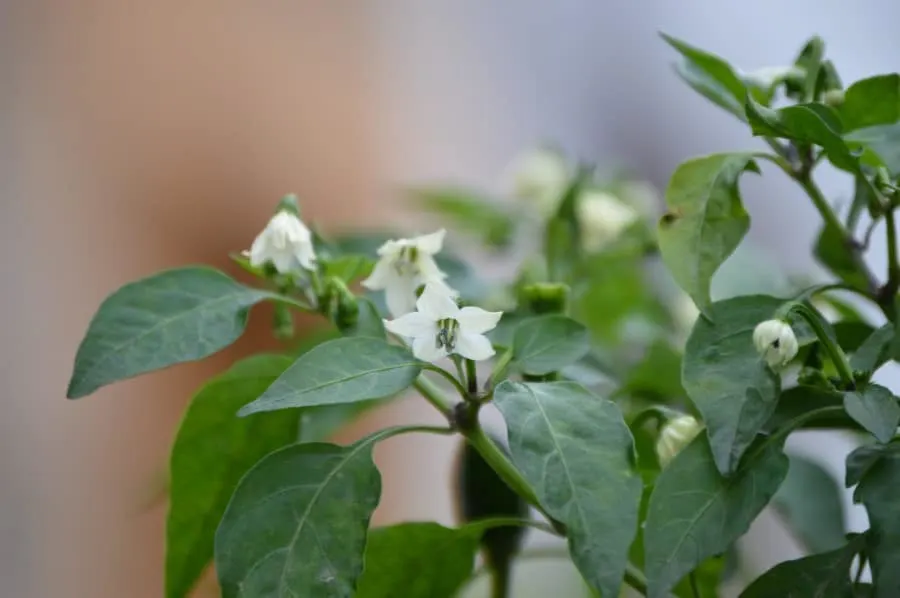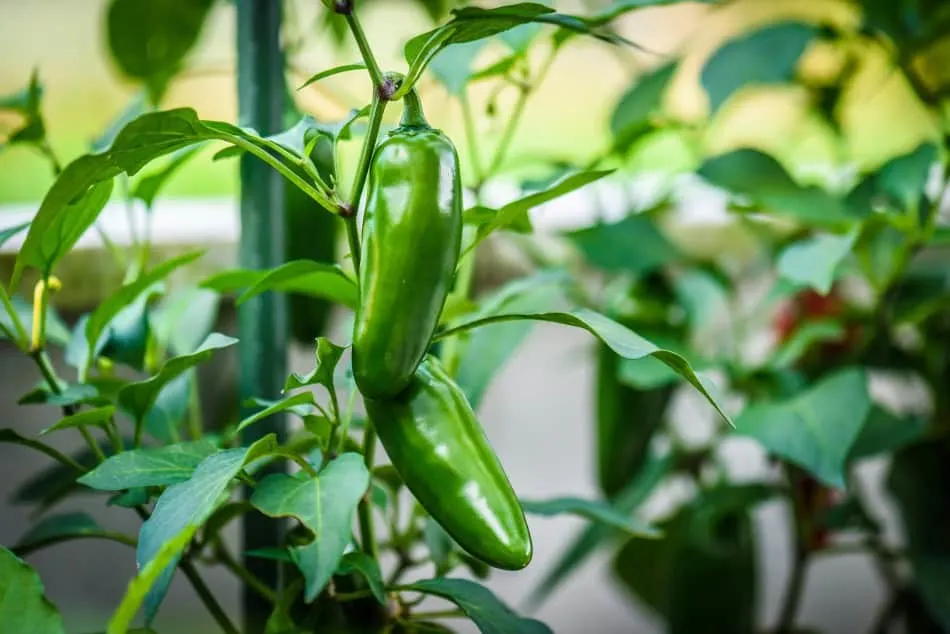When you picture a pepper plant, you might not imagine little white flowers popping up all over the place. However, if you grow peppers in your garden, that is precisely what you should expect and get. But why is your pepper plant flowering?
Your pepper plant is flowering because it has entered the next stage of its growth cycle. There are two common explanations: the pepper plant doesn’t have enough room to grow, or it’s about to start producing peppers. If it’s flowering but not producing fruit, it might need help with pollination.
The flowers on your pepper plant are the beginnings of the actual pepper. Understanding what encourages a plant to flower will help you maximize your pepper yield for healthy and delicious plants. Read on to learn what makes a pepper plant flower and what to do if your plant flowers too soon.

What Triggers a Pepper Plant to Flower?
Flowering is a normal part of a pepper plants lifecycle. The flowers are the first stage of the plant’s reproductive cycle and will eventually turn into seed-bearing fruits.
Pepper plants will begin flowering when they reach full size and maturity or run out of growing room, whichever comes first. After a pepper plant first flowers, as long as they continue getting adequate water and nutrition, they will put all of their energy into the reproductive cycle and continue producing flower which when pollinated turn into pepper pods.
Why do Pepper Plants Have Flowers?
Peppers are angiosperms, a type of plant that reproduces via flowering and fruiting. The flowers of an angiosperm contain the plant’s reproductive system. The edible part of the plant, the pepper, is the final growth stage of the flower.
There is pollen inside a pepper plant’s blooms and reproductive structures equipped to catch pollen from other pepper plants. Outdoors, pollinators like birds and insects help spread pollen from flower to flower to fertilize the plants.
Fertilized flowers will grow into fruits, the botanical term for the ripe, fleshy part of a plant that contains seeds. The flesh develops out of the plant’s ovaries or carpels, and these plant structures initially grow in the flowers.
How Long After Flowering Will Your Pepper Plant Fruit?
The flowers on your pepper plant won’t last that long; most begin to set fruit in three to five days after pollination. In contrast, it takes between 55 and 150 days for most pepper fruit to ripen fully. You’ll know the fruit is fully ripe when it’s firm and dark green, but most varieties will continue to ripen to a red color if you leave them on the plant.
Peppers have a long growing season, so you can harvest the fruits as they ripen. Some plants may produce two or more crops during a single season. But as long as your pepper plants are still flowering, there’s still the potential for more fruit to grow.
Why is Your Pepper Plant Flowering but Not Producing Fruit?
Pepper blossoms won’t turn into pepper fruits unless the flowers are pollinated. If you’re growing your peppers indoors, you’ll need to hand-pollinate them, as they don’t have access to birds and insects that usually complete this process.
To hand pollinate, you’ll need to take pollen from one plant and put it in another (of the same variety, for best results). A small, fine tipped paintbrush is a useful tool for this process. Gently swirl the brush in the flower, and the pollen will stick to the brush bristles. Then, brush the inside of another plant’s flowers to deposit the pollen. Repeat this process with all of your pepper plants.
Outside of pollination issues, your pepper plant could also have trouble producing fruit if it isn’t getting proper nutrition. Pepper plants need nitrogen to grow foliage, but too much nitrogen will prevent the plant from flowering or fruiting. Too little calcium will prevent the plant from growing the strong cell walls the fruit needs and can lead to rotting flowers and fruit.

How Big Should the Pepper Plant Be Before Flowering?
Most pepper plants grow to be about three feet tall, though some varieties are as short as a foot or as tall as six feet. Regardless of size, your plant should reach maturity before it starts flowering.
Pepper seeds take two to three weeks to germinate, and seedlings take an additional eight to ten weeks to produce their first pepper fruits. If your plants start to flower before reaching their full height, you might want to consider pinching off the flowers to encourage the plant to reach maturity before flowering.
An immature plant will begin flowering if there isn’t enough room to expand its root network or grow any taller. If your outdoor plants are flowering early, consider transplanting them to an area with more space.
How Tall Does a Pepper Plant Usually Get Before it Starts to Flower?
The average Bell pepper plant will reach about two and a half feet before it begins to flower and fruit. The size of the pepper fruit is a good guideline for how tall a mature plant should be. Smaller pepper varieties won’t grow as tall as their larger-fruited cousins.
Should You Remove Flowers from Your Pepper Plants?
Whether or not you remove flowers from your plants depends on how early it is in the season and your plans for harvesting. Growing flowers takes a lot of energy, and when you remove flowers, you’re forcing the plant to redirect that energy to something else.
If you have strong, mature pepper plants growing in their final planted location, you should leave the plant’s flowers if you want them to fruit. Without flowers, the pepper plant cannot produce any fruit at all. There are, however, reasons to remove flowers in certain circumstances.
Because producing and ripening fruit requires energy, plants with an overabundance of blossoms won’t produce as much fruit as a plant with the same nutrient access and pollination but fewer flowers. If the plant’s resources are limited, it may be beneficial to remove some blooms by pinching off the flower.
Does Removing Flowers Encourage Fruit Production?
Removing the flowers from your pepper plant will not encourage fruit production. However, strategically removing early blooms will help you grow pepper plants to full maturity which will give a healthier crop later in the growing season. This is particularly true for indoor plants.
The fruit is made from the flower, so you’re taking a potential fruit when you take a flower off the plant. However, removing flowers could be beneficial because when the plant blooms too soon in the season, it might not be ready to sustain fruit. This is particularly common with indoor plants that have run out of room to grow a larger root network but still aren’t fully mature.
If your plant focuses its energy on producing fruit instead of establishing a robust root network, it may not be able to support the fruit to maturity. When you remove early blooms, the plant has to refocus on other growth stages.
Closing Thoughts
Pepper plants flower in preparation to produce fruit. It’s a normal part of the growing process, but it can be prematurely triggered by limited growth space, like a container. Nutrient imbalances and other changes in growing conditions can impact how soon a pepper plant flowers and how many flowers it produces. When your pepper plant flowers, it’s a sign that the plant is getting ready to move on to the next growth stage.
Here are Some of my Favorite Gardening Products and Tools
Thank you for reading this article. I hope you found it helpful for growing some new plants in your home or garden. Here are some products I like that I hope you’ll also find helpful. These are affiliate links, and I am compensated for referring traffic. But in all honesty, these are the exact product that I use or recommend to everyone.
Soil: For high-quality soil, I really like Fox Farm Ocean Forest. I do all my growing in containers and this soil has worked great for me. I like how they use nutrient-rich contents like earthworm castings, bat guano, and composted crab and fish.
Fertilizer: Currently I am using a seaweed-based organic fertilizer call Neptunes Harvest. This is a great milder fertilizer option if you want to use something organic. If you want a more powerful fertilizer, I recommend Fox Farm Liquid Nutrient Trio, lots of people have had great growing success with this product.
Pruning Shears: Pruning shears are one of the most useful gardening tools to have because it’s important to prune your plants to keep them healthy. The pruning shears I recommend are the Gonicc 8’’ pruning shears. I like them because they are built sturdy and work both on bigger and smaller plants, so you don’t need to have multiple pruning shears.
spicytrio.com is a participant in the Amazon Services LLC Associates Program, an affiliate advertising program designed to provide a means for sites to earn advertising fees by advertising and linking to Amazon.com. spicytrio.com also participates in affiliate programs with other sites. spicytrio.com is compensated for referring traffic and business to these companies.
